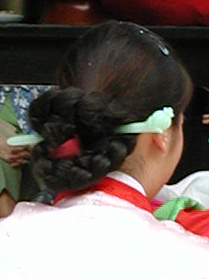Binyeo
Binyeo is a traditional Korean hairpin used to hold a hairstyle in place. It is a significant cultural artifact that has been part of Korean dress since ancient times. Binyeo were not only functional but also decorative, often reflecting the social status, age, and marital status of the wearer. They were typically made from materials such as metal, wood, bamboo, or jade, and could be elaborately decorated with jewels or intricate designs.
History[edit | edit source]
The use of binyeo dates back to the Three Kingdoms of Korea, a period that lasted from 57 BC to 668 AD. Initially, binyeo were used by both men and women to fasten their hair up. However, over time, the use of binyeo became more gender-specific, predominantly worn by women. The design and material of binyeo evolved through various Korean dynasties, such as the Goryeo (918–1392) and Joseon (1392–1897) dynasties, reflecting the changing tastes and societal norms of each era.
Types and Designs[edit | edit source]
Binyeo can be classified into several types based on their design and the materials used. The most common types include:
- Jjakdae Binyeo: A long, thin hairpin, often made of metal, used to hold a bun in place. - Cheopji Binyeo: A decorative hairpin with a flat, wide end, typically used in bridal or royal hairstyles. - Euijok Binyeo: A hairpin adorned with auspicious symbols or characters, believed to bring good fortune to the wearer.
The design of binyeo often incorporated symbols with specific meanings. For example, a binyeo with a phoenix design might symbolize the wish for a peaceful and prosperous life, while a dragon design could represent power and authority.
Cultural Significance[edit | edit source]
Binyeo were more than just hair accessories; they were imbued with cultural significance. The choice of binyeo could communicate a woman's social status, as the materials and complexity of the design were often indicative of the wearer's wealth and position in society. Additionally, the transition from wearing simple hairpins to more elaborate binyeo designs marked important life stages for Korean women, such as marriage.
In traditional Korean weddings, the bridal binyeo is a key component of the bride's attire, symbolizing her married status and the hope for a harmonious and prosperous marriage. Binyeo also play a role in traditional Korean ceremonies and festivals, where they are worn as part of the ceremonial dress.
Modern Usage[edit | edit source]
Today, binyeo are still used in Korea, though primarily for special occasions such as weddings, traditional performances, and cultural festivals. They are celebrated as a symbol of Korean heritage and are often featured in historical dramas and cultural exhibitions. Modern interpretations of binyeo incorporate contemporary design elements, making them appealing to a wider audience while still preserving their traditional significance.
See Also[edit | edit source]
Search WikiMD
Ad.Tired of being Overweight? Try W8MD's physician weight loss program.
Semaglutide (Ozempic / Wegovy and Tirzepatide (Mounjaro / Zepbound) available.
Advertise on WikiMD
|
WikiMD's Wellness Encyclopedia |
| Let Food Be Thy Medicine Medicine Thy Food - Hippocrates |
Translate this page: - East Asian
中文,
日本,
한국어,
South Asian
हिन्दी,
தமிழ்,
తెలుగు,
Urdu,
ಕನ್ನಡ,
Southeast Asian
Indonesian,
Vietnamese,
Thai,
မြန်မာဘာသာ,
বাংলা
European
español,
Deutsch,
français,
Greek,
português do Brasil,
polski,
română,
русский,
Nederlands,
norsk,
svenska,
suomi,
Italian
Middle Eastern & African
عربى,
Turkish,
Persian,
Hebrew,
Afrikaans,
isiZulu,
Kiswahili,
Other
Bulgarian,
Hungarian,
Czech,
Swedish,
മലയാളം,
मराठी,
ਪੰਜਾਬੀ,
ગુજરાતી,
Portuguese,
Ukrainian
Medical Disclaimer: WikiMD is not a substitute for professional medical advice. The information on WikiMD is provided as an information resource only, may be incorrect, outdated or misleading, and is not to be used or relied on for any diagnostic or treatment purposes. Please consult your health care provider before making any healthcare decisions or for guidance about a specific medical condition. WikiMD expressly disclaims responsibility, and shall have no liability, for any damages, loss, injury, or liability whatsoever suffered as a result of your reliance on the information contained in this site. By visiting this site you agree to the foregoing terms and conditions, which may from time to time be changed or supplemented by WikiMD. If you do not agree to the foregoing terms and conditions, you should not enter or use this site. See full disclaimer.
Credits:Most images are courtesy of Wikimedia commons, and templates Wikipedia, licensed under CC BY SA or similar.
Contributors: Prab R. Tumpati, MD

